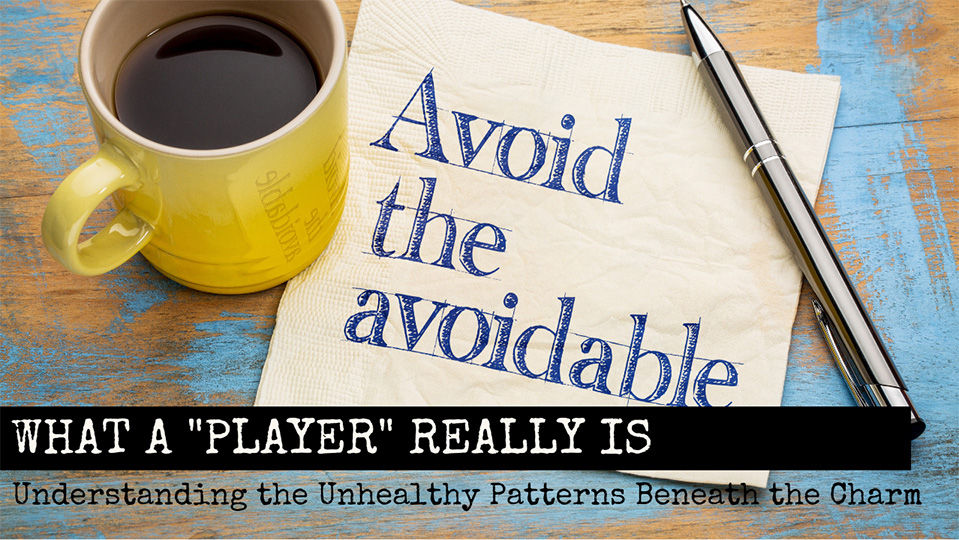What a "Player" Really Is: Understanding the Unhealthy Patterns Beneath the Charm
- Brandilyn Hallcroft
- Oct 25, 2024
- 4 min read
Updated: Nov 20, 2024
The term “Player” has been used for decades, often glamorized as charming, elusive, and hard to pin down. But beneath the superficial allure lies a deeper, more troubling pattern of behavior shaped by emotional avoidance and commitment fears. A “Player” isn’t just a heartbreaker; they engage in a behavior cycle rooted in avoidant attachment style—a dynamic that impacts everyone involved, including themselves.

Defining the "Player": A Symptom of Avoidant Attachment Style
A "Player" is often someone who, consciously or subconsciously, avoids emotional closeness. Attachment theory explains that many of us form an “attachment style” early in life based on our caregivers' availability and responses to our needs. Those with an avoidant attachment style may have learned that closeness was uncomfortable, unreliable, or frightening, causing them to prioritize independence over intimacy. This leads to distancing tactics, manipulation, and avoidance in romantic relationships, creating a pattern of elusive behavior.
Players use charm and allure to create connections but maintain these relationships at arm's length, dismissing or avoiding deep emotional bonds. They may juggle multiple relationships, using flattery and affection only when it serves to keep the other person invested—without committing. This cycle feeds their need for control and emotional distance.
The Emotional and Mental Impact of Playing Games
The mental and emotional toll of being involved with a “Player” is severe. For the individual on the receiving end, this behavior can trigger a cascade of negative emotions, from self-doubt and heartbreak to anxiety and insecurity. The unpredictability of someone who comes and goes creates an emotional rollercoaster for their partners, leading to feelings of inadequacy and worthlessness.
For the "Player" themselves, this pattern isn’t without consequences. Emotional avoidance perpetuates a cycle of loneliness and detachment, making true connection and intimacy feel nearly impossible. The short-term rewards of the “Player” lifestyle—validation, attention, ego boosts—only distract from the underlying loneliness and unresolved emotional wounds.
The Physical Risks: Health Dangers Beyond Emotions
Playing with people’s emotions is not just dangerous mentally and emotionally but physically as well. There’s an inherent risk in juggling multiple intimate relationships, as “Players” often do. Relationships with emotionally unstable or hurt individuals can lead to volatile reactions, potentially putting both parties at physical risk. Hurt, rejection, and betrayal can trigger intense, even unpredictable responses, leading to confrontations that may spiral out of control.
Moreover, frequent, unprotected intimacy can increase the risk of sexually transmitted infections (STIs), not only for the "Player" but also for their unsuspecting partners. The disregard for safe practices often brushed aside in favor of spontaneity or thrill, makes STI transmission a real and often unacknowledged danger in the lifestyle of a “Player.” This can lead to a cycle of exposure and infection, leaving long-term health repercussions for everyone involved.
Recognizing and Breaking the Pattern: Toward Healthy Connection
Understanding that “Player” behavior stems from avoidant attachment patterns opens the door to breaking the cycle. This requires a conscious choice to heal unresolved trauma, work on emotional awareness, and challenge the behaviors driving the avoidance. Therapy, self-reflection, and learning about healthy attachment styles can help individuals with these patterns form more secure, fulfilling relationships.
For those on the receiving end, recognizing these signs early can prevent emotional entanglement and protect one's mental health. Knowing the dynamics behind “Player” behavior can empower individuals to set boundaries, safeguard their self-worth, and prioritize relationships rooted in respect and authenticity.
We need to get a clue and stop glorifying or excusing this damaging behavior as a society. The romanticization of "Players" in media and pop culture only serves to normalize emotional avoidance, creating a harmful cycle where emotional detachment and manipulative behavior are mistaken for charm and independence. By understanding the roots of these patterns and calling them out, we can collectively discourage behaviors that hurt everyone involved.
It’s time to place value on relationships built on respect, honesty, and emotional presence. Encouraging healthy attachment, emotional maturity, and genuine intimacy should become the standard we aspire to in relationships, allowing us all to cultivate fulfilling, authentic, and truly empowering connections. We can only foster a culture where emotional well-being and integrity are prioritized over fleeting charm. By shifting our expectations, we can foster a culture where emotional well-being and integrity are prioritized over fleeting charm.
"Attached: The New Science of Adult Attachment and How It Can Help You Find – and Keep – Love" by Amir Levine and Rachel Heller
"Hold Me Tight: Seven Conversations for a Lifetime of Love" by Dr. Sue Johnson
"The Power of Attachment: How to Create Deep and Lasting Intimate Relationships" by Diane Poole Heller
Disclaimer: Journaling is a powerful tool to support your healing process. The CBT exercises in Journals to Healing journals are intended to help you analyze and reframe your thoughts as part of a personal growth journey. However, these journals do not replace therapy or professional help. If you are experiencing intense emotions or feelings beyond your control, please seek professional assistance. Resources such as the National Suicide Prevention Lifeline (988) and Crisis Text Line (Text HOME to 741741) are available 24/7 for support. Remember, reaching out for help is a strength, and healing is a process.

Comments